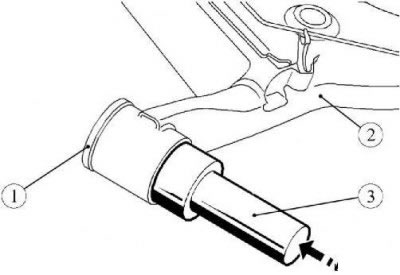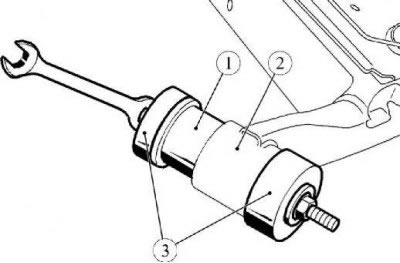Removing
Place the vehicle on a two post lift and turn off the ignition.
Remove rear wheels.
Remove the rear wheel speed sensor harnesses from the holders on the rear suspension arms.
Unscrew the bolts securing the speed sensors to the rear brake shields and remove the sensors (replaceable nozzle Torx T30, extension, ratchet wrench).
- disconnect the rear brake pressure regulator drive rod from the rear suspension arm beam;
- remove the hand brake cables from the holders on the rear suspension arms;
- remove the brake drums;
- disconnect the cables of the manual brake drive from the levers of the brake shoe drive and remove the tip of the cable from the holes in the brake shields;
- disconnect the brake pipes from the flexible brake hoses, the brake hoses must remain on the rear suspension arms.
Disconnect the shock absorbers from the rear suspension arms and remove the springs.
Install the transmission strut under the center of the rear suspension arm beam (transmission rack type OMA 604).
Unscrew the nuts of the bolts securing the rear suspension arms to the brackets, lower the transmission rack and remove the rear suspension arms from the vehicle. The operation is performed by two performers (interchangeable head 18, extension and collar).
Replacement of rubber-metal hinges

Figure 7-1 - Marking the location of the hinge in the rear suspension arm: M1 - mark on the rear suspension arm; M2 - mark on the hinge body
Attention. Before removing the rubber-metal joint, it is necessary to note its orientation in the hole of the rear suspension arm:
- make marks "M," And "M2" on the rear suspension arm and hinge;
- copy label "M2 " to a new hinge.
Note. The marking of the hinges is necessary for proper installation and prevention of premature wear of the hinges of the rear suspension arms, as well as to ensure reliable vehicle handling.

Figure 7-2 - Pressing out the hinge: 1 - hinge of the rear suspension arm; 2 - rear suspension arm; 3 - mandrel for pressing out from the set Tag. 1838
Press the rubber-metal joint from the rear suspension arm (mandrel for pressing out from the set Tag. 1838, hammer).
Install a new rubber-to-metal joint 1, Figure 7-3, in the hole of the arm 2 of the rear suspension and align the marks "M1" And "M2", Figure 7-1.

Figure 7-3 - Pressing the hinge: 1 - hinge of the rear suspension arm; 2 - rear suspension arm; 3 - fitting tool from Tag. 1838
Install tool 3, Figure 7-3, on the joint for pressing and press the joint into the rear suspension arm (pressing tool from Tag. 1838, ring key 17-2 pcs.).
Perform operations to replace the hinge for the second arm.
Installation
Install the rear suspension arms on the transmission rack and align under the vehicle opposite the attachment points. The operation is performed by two performers (transmission rack type OMA 604, "Automotive equipment" Pskov).
Install the rear suspension arms in the mounting brackets on the body, insert the bolts and tighten, without tightening, the nuts (ring key 18, interchangeable head 18, knob).
Set the rear suspension arms to the position for tightening the rubber-metal joints and finally tighten the nuts of the rear suspension arms mounting bolts in the brackets.
Install the springs and connect the shock absorbers to the rear suspension arms.
- install the manual brake cables in the holders on the rear suspension arms;
- install the tips of the cables of the manual brake drive into the holes of the brake shields and connect them to the levers of the brake shoe drive;
- install brake drums;
- connect the brake pipes to the flexible brake hoses on the rear suspension arms;
- connect the rear brake pressure regulator drive rod to the rear suspension arm beam and adjust the pressure regulator drive.
Install the speed sensors in the holes of the brake shields and fix them with bolts. Bolt tightening torque 14 Nm (1.4 kgf·m) (replaceable nozzle Torx T30, extension, ratchet wrench, torque wrench).
Install the rear wheel speed sensor harnesses into the holders on the rear suspension arms.
Bleed the brake system and, if necessary, the clutch hydraulic drive.
Install rear wheels.
Check the efficiency of the service brake system.
